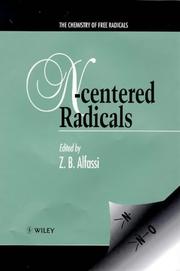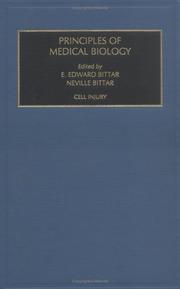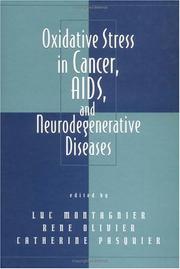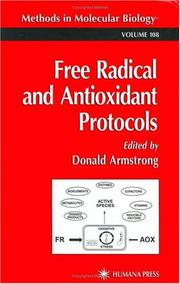| Listing 1 - 6 of 6 |
Sort by
|

ISBN: 9780471961864 0471961868 Year: 1998 Publisher: Chichester: Wiley,
Abstract | Keywords | Export | Availability | Bookmark
 Loading...
Loading...Choose an application
- Reference Manager
- EndNote
- RefWorks (Direct export to RefWorks)

ISBN: 0813556155 0585023085 9780585023083 0813525748 0813525756 Year: 1998
Abstract | Keywords | Export | Availability | Bookmark
 Loading...
Loading...Choose an application
- Reference Manager
- EndNote
- RefWorks (Direct export to RefWorks)
What are antioxidants? What do they do? Should you be taking them? How much is enough, or too much? Dr. John Smythies explores these and other questions you need to have answered about antioxidants in Every Persons Guide to Antioxidants. Oxidants are naturally occuring chemicals in our bodies that derive from oxygen to facilitate essential biochemical processes. However, most oxidants are potentially toxic molecules and the body contains a number of antioxidants for protection against these toxic effects. Overproduction of oxidants, or underproduction of antioxidants, leads to oxidative stress, which has been linked to a wide range of chronic diseases, including heart disease, cancer, diabetes, and Alzheimers. Smythies thoroughly evaluates current scientific work on this subject and suggests that a high proportion of many of these diseases can be prevented, or their onset delayed, by proper intake of antioxidants. He examines the pros and cons of the debate over how this necessary intake should be achieved, by eating more fruits and vegetables or by taking supplements in pill form. Smythies surveys the toxicity of antioxidants and recommends under what circumstances they should be given with caution or not at all. He also discusses whether taking supplements requires medical supervision and lists good sources of antioxidants in fruits and vegetables
Oxidation, Physiological --- Antioxidants --- Free Radicals (Chemistry) --- Science --- Medical --- Oxidation, physiological --- Free radicals (chemistry)

ISBN: 9781559388184 1559388188 9780080528779 0080528775 Year: 1998 Publisher: [Place of publication not identified] JAI Press
Abstract | Keywords | Export | Availability | Bookmark
 Loading...
Loading...Choose an application
- Reference Manager
- EndNote
- RefWorks (Direct export to RefWorks)
At no time since the introduction of cell pathology by Virchov more than a century ago has the outlook for pathology as an integrated discipline been brighter. It is surely clear that the revolution of molecular biology and biotechnology has wrought profound changes in the various basic medical sciences including pathology. But to say this is hardly enough, particularly since the burgeoning field of molecular pathology has been challenged and altered by a powerful concept, namely, programmed cell death. Called apoptosis, which in Greek means falling off, it is intimately connected with cell removal and regeneration; that is, with tissue homeostasis. Nowhere is this more dramatically illustrated as a physiological process than in the gut, endometrium, and embryo. Similarly, little doubt is left that clusters of apoptotic-induced genes are involved in the control of carcinogenesis. The evidence for this is already compelling; it is plain, for instance, that p53 triggers apoptosis whenever DNA repair is incomplete. The question now is, how quickly can the Genome project shed some light on the genetics underlying apoptosis? It is tolerably clear that there is no such thing as a general model of cell injury, but there are models, as it should be. One thing is already certain: cell stress during septicemia is the quintessential model. Death here requires the failure of at least three organs! We are told that oxidative stress plays a major role in the pathogenesis of the syndrome. This is not surprising. The whole subject of reactive oxygen species (ROS) is thus given much weight. By far, the most important mechanisms underlying membrane lesions, due to ROS, are those involving inactivation of several key enzymes among a host of enzymes, lipid peroxidation, and iron speeding up bydroxyl radical production. The stark fact is that evolutionary pressure has produced a fiasco by not endowing the cell with enough antioxidant power or reducing the ROS pool. In organs with high O2 consumption, mitochondrial leakage of O2 (the superoxide anion) could well be considerable. Thus our main point here is that caloric restriction gives us a way of tackling the problem for the time being. One has only to remember that it improves survival. Whether there has been a "breakthrough" is not yet quite certain, but oxidative stress combined with long-term overactivation of glutamate receptors may enable us to understand several neurodegenerative disorders including Parkinson's disease. This broad topic is touched upon in detail in the Neurobiology module (Volume 14). There is a vast literature relating to injury of heart muscle. Two chapters address this topic. Looking back, are we to conclude that a membrane lesion, which is essentially functional, does not exist? Consider, as an example, the NMR experiments in which a raised Pco2, leads very rapidly to a fall in heart muscle pH. We also venture whether it begs several fundamental questions relating to events that precede the onset of necrobiosis. A telling argument is that an early event could be as simple as the root of the problem in ischemia is not as simple as that of a leaky membrane. But the initiating event would seem to be a redox imbalance vix., changes in cytosolic and mitochondrial NAD+/NADH. We urge the student to go back to Volume 4 (Part II) and read, once more, the chapter on Cellular ATP by Harris. In Part IV, the chapter on the Human Heat Shock Response by Jurivich merits a second reading. Though the present volume is a veritable source of many unanswered questions, it has the distinct simplicity of telling us that molecular pathology, like molecular biology, represents a way of thinking.
Histology. Cytology --- Human histology. Human cytology --- Human medicine --- Pathology, Cellular --- Apoptosis --- Free radicals (Chemistry) --- Heart cells --- Anatomy --- Phenomena and Processes --- Medicine --- Cell Physiological Phenomena --- Cells --- Pathology --- Health Occupations --- Disciplines and Occupations --- Health & Biological Sciences --- Pathophysiology

ISBN: 0824798627 Year: 1998 Volume: 1 Publisher: New York : M. Dekker,
Abstract | Keywords | Export | Availability | Bookmark
 Loading...
Loading...Choose an application
- Reference Manager
- EndNote
- RefWorks (Direct export to RefWorks)
Oxidative Stress --- Neoplasms --- Acquired Immunodeficiency Syndrome --- Nervous System Diseases --- Free radicals (Chemistry) --- Oxidation, Physiological. --- Stress (Physiology) --- Cancer --- AIDS (Disease) --- Nervous system --- Radicaux libres (Chimie) --- Oxydation biologique --- Stress --- physiology. --- physiopathology. --- physiopathology. --- physiopathology. --- Pathophysiology. --- Pathophysiology. --- Pathophysiology. --- Degeneration --- Pathophysiology. --- Physiopathologie

ISBN: 0896034720 058523566X 9786610835980 1280835982 1592592546 9780896034723 Year: 1998 Volume: 108 Publisher: Totowa : Humana Press,
Abstract | Keywords | Export | Availability | Bookmark
 Loading...
Loading...Choose an application
- Reference Manager
- EndNote
- RefWorks (Direct export to RefWorks)
In Free Radical and Antioxidant Protocols, seventy-six leading international authorities describe cutting-edge methodologies for quantifying free radical and antioxidant analytes in tissue and body fluids using experimental models and in vitro procedures. These user-friendly and easily reproducible techniques cover the essential tasks, including radical generating systems, direct measurement or trapping of reactive radical species and acute-phase proteins, and measurement of metabolic intermediates derived from the oxidation of lipids, proteins, and nucleic acids. There are also methods for the determination of vitamin, enzymatic, and water-soluble antioxidants, as well as of essential micronutrients and cofactors. The techniques take advantage of new instrumentation-probes, photon counting, chemiluminescence, and caged compounds, with an emphasis on HPLC-and are adaptable to a wide range of applications. Free Radical and Antioxidant Protocols provides state-of-the-art methodology and biotechnology in a convenient format for both academic and corporate biomedical scientists. The detailed, laboratory-tested free-radical assays, many of them presented here for the first time, will illuminate the study of both primary and secondary oxidative stress and contribute significantly to our understanding of the many disorders associated with this process.
Analytical biochemistry --- Free radicals (Chemistry) --- Antioxidants --- Oxidation, Physiological --- Stress (Physiology) --- Pathophysiology --- Laboratory manuals. --- Physiological effect --- Research --- Laboratory manuals --- Enzymes --- Oxygène --- Oxygen --- Consommation d'oxygène --- Oxygen consumption --- Métabolisme des lipides --- Lipid metabolism --- Oxydation --- Oxidation --- Life sciences. --- Biochemistry. --- Life Sciences. --- Biochemistry, general. --- Biological chemistry --- Chemical composition of organisms --- Organisms --- Physiological chemistry --- Biology --- Chemistry --- Medical sciences --- Biosciences --- Sciences, Life --- Science --- Composition --- Biological oxidation --- Oxidation, Biological --- Physiological oxidation --- Biochemistry --- Chemical inhibitors --- Physiological stress --- Tension (Physiology) --- Adaptation (Biology) --- Radicals (Chemistry) --- Free radical reactions --- Free radicals (Chemistry) - Pathophysiology - Laboratory manuals --- Antioxidants - Physiological effect - Laboratory manuals --- Oxidation, Physiological - Laboratory manuals --- Stress (Physiology) - Research - Laboratory manuals

ISBN: 1559388188 9781559388184 9780080528779 0080528775 Year: 1998 Publisher: Stamford, Conn. JAI Press
Abstract | Keywords | Export | Availability | Bookmark
 Loading...
Loading...Choose an application
- Reference Manager
- EndNote
- RefWorks (Direct export to RefWorks)
Pathology, Cellular --- Apoptosis --- Free radicals (Chemistry) --- Heart cells --- Anatomy --- Phenomena and Processes --- Medicine --- Cell Physiological Phenomena --- Cells --- Pathology --- Health Occupations --- Disciplines and Occupations --- Health & Biological Sciences --- Pathophysiology --- Health Professions --- Health Occupation --- Health Profession --- Profession, Health --- Professions, Health --- Occupations --- Pathologies --- Disease --- Cell --- Cell Biology --- Cell Physiological Phenomenon --- Cell Physiological Process --- Physiology, Cell --- Cell Physiological Processes --- Cell Physiology --- Phenomena, Cell Physiological --- Phenomenon, Cell Physiological --- Physiological Process, Cell --- Physiological Processes, Cell --- Process, Cell Physiological --- Processes, Cell Physiological --- Medical Specialities --- Medical Specialties --- Medical Specialty --- Specialities, Medical --- Specialties, Medical --- Specialty, Medical --- Medical Speciality --- Speciality, Medical --- Health Workforce --- Anatomies --- Cardiac cells --- Cardiocytes --- Cardiomyocytes --- Heart --- Radicals (Chemistry) --- Free radical reactions --- Cell death --- Cellular pathology --- Cytopathology --- Cytodiagnosis --- pathology --- physiology --- Cytology
| Listing 1 - 6 of 6 |
Sort by
|

 Search
Search Feedback
Feedback About
About Help
Help News
News